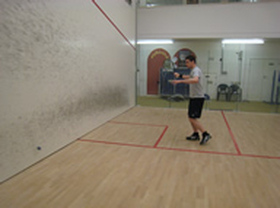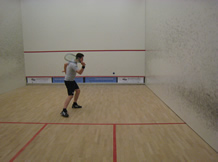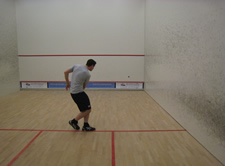
The drive kill is an effective way to move the ball to the front of the court without the worry of the ball sitting up and your opponent hitting an easy winner on you.
The problem with drop shots in all racket sports are that they leave you exposed. Tennis, badminton, squash and table tennis all have this problem. The drive kill is an effective way to move the ball to the front corners without risking opening the court up.
When hitting this shot use the edge of the racket, with a the very similar technique that you would use for the straight drop. Experiment with the pace and use as much as you feel comfortable with.
Aim low, maybe only an inch above the tin and for the ball to then hit the front wall and then floor before touching and running alongside the side wall. It’s very difficult to get the racketball to stay in the nick especially if you don’t have a good angle and as you’re hitting the ball hard if you miss the nick then the ball is likely to come out away from the wall and into the middle of the court, giving all the momentum back to your opponent.
Target - Aim to hit the front wall then the floor before the ball hits the side wall. The ultimate aim of the shot is for the ball to clip and run along the side wall. If executed well this should be a risk free shot, you are unlikely to give away your control of the rally and if you manage to hit the ball tight it could be a winner.
The photos below shows the shot in action.
- Start with a short swing
- Use plenty of cut
- Follow through to the corner
- Racket head speed is key, you want the ball to move as quickly as possible to the front wall to give you the best chance of hitting a winner
- This shot is not just a fast drop shot it should be decisively quicker than that
You might think the objective of the shot is to hit a winner to the front like the drop but with the kill you shouldn’t really be looking to make the ball bounce twice before your opponent can reach it.
If you can hit the shot tight enough then it might count as a winner no matter where its second bounce ends up.
Your objective with this shot should be to hit the ball low so that even if you don’t manage to get the ball tight your opponent will have to hit up on the ball which hugely reduces their attacking options.
This can be a really effective shot on the backhand as well as the forehand. The reason why the shot is more readily used on the forehand is all to do with racket head speed. It is a lot more difficult to bring the racket head through the ball quickly on the backhand which can then open you up to issues with the ball sitting up at the front of the court.
If you can hit the shot tight enough then it might count as a winner no matter where its second bounce ends up.
Your objective with this shot should be to hit the ball low so that even if you don’t manage to get the ball tight your opponent will have to hit up on the ball which hugely reduces their attacking options.
This can be a really effective shot on the backhand as well as the forehand. The reason why the shot is more readily used on the forehand is all to do with racket head speed. It is a lot more difficult to bring the racket head through the ball quickly on the backhand which can then open you up to issues with the ball sitting up at the front of the court.



